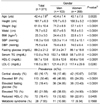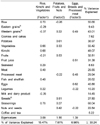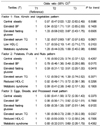1. Kant AK, Andon MB, Angelopoulos TJ, Rippe JM. Association of breakfast energy density with diet quality and body mass index in American adults: National Health and Nutrition Examination Surveys, 1999-2004. Am J Clin Nutr. 2008. 88:1396–1404.
2. Kim SH. Children's growth and school performance in relation to breakfast. J Korean Diet Assoc. 1999. 5:215–224.
3. Lee SH, Shim JS, Kim JY, Moon HA. The effect of breakfast regularity on eating habits, nutritional and health status in adults. Korean J Nutr. 1996. 29:533–546.
4. Pereira MA, Erickson E, McKee P, Schrankler K, Raatz SK, Lytle LA, Pellegrini AD. Breakfast frequency and quality may affect glycemia and appetite in adults and children. J Nutr. 2011. 141:163–168.

5. Rogers PJ. How important is breakfast? Br J Nutr. 1997. 78:197–198.

6. Ruxton CH, Kirk TR. Breakfast: a review of associations with measures of dietary intake, physiology and biochemistry. Br J Nutr. 1997. 78:199–213.

7. Williams P. Breakfast and the diets of Australian adults: an analysis of data from the 1995 National Nutrition Survey. Int J Food Sci Nutr. 2005. 56:65–79.

8. Juang SJ, Peng LN, Lin MH, Lai HY, Hwang SJ, Chen LK, Chiou ST. Metabolic characteristics of breakfast-vegetarian (BV) elderly people in rural Taiwan. Arch Gerontol Geriatr. 2010. 50:20–23.

9. Shim JE, Paik HY, Moon HK. Breakfast consumption pattern, diet quality and health outcomes in adults from 2001 National Health and Nutrition Survey. Korean J Nutr. 2007. 40:451–462.
10. Siega-Riz AM, Popkin BM, Carson T. Differences in food patterns at breakfast by sociodemographic characteristics among a nationally representative sample of adults in the United States. Prev Med. 2000. 30:415–424.

11. Cho S, Dietrich M, Brown CJ, Clark CA, Block G. The effect of breakfast type on total daily energy intake and body mass index: results from the Third National Health and Nutrition Examination Survey (NHANES III). J Am Coll Nutr. 2003. 22:296–302.

12. Hu FB. Dietary pattern analysis: a new direction in nutritional epidemiology. Curr Opin Lipidol. 2002. 13:3–9.

1. di Giuseppe R, Di Castelnuovo A, Melegari C, De Lucia F, Santimone I, Sciarretta A, Barisciano P, Persichillo M, De Curtis A, Zito F, Krogh V, Donati MB, de Gaetano G, Iacoviello L. on behalf of the Moli-sani Project Investigators. Typical breakfast food consumption and risk factors for cardiovascular disease in a large sample of Italian adults. Nutr Metab Cardiovasc Dis. Forthcoming 2010. doi:
10.1016/j.numecd.2010.07.006.

14. Choi J, Lee JM. The perception and attitude of food experts in New York city toward Korean food: assessed by in-depth interviews of "Foodies". Korean J Food Cult. 2010. 25:126–133.
15. Song Y, Joung H. A traditional Korean dietary pattern and metabolic syndrome abnormalities. Nutr Metab Cardiovasc Dis. Forthcoming 2011. doi:
10.1016/j.numecd.2010.09.002.

16. Kim YO. Dietary patterns associated with hypertension among Korean males. Nutr Res Pract. 2009. 3:162–166.

17. Ministry of Health and Welfare, Korea Centers for Disease Control and Prevention. 2008 National Health Statistics. 2008.
18. Kang H, Jung HJ, Paik HY. Analysis of foods and nutrients intake obtained at the final probing step in 24-hour recall method. Korean J Nutr. 2009. 42:158–170.

19. Noh HY. The association of long-term dietary patterns and changes in body composition in Korean early adolescent girls [master's thesis]. 2008. Seoul: Seoul National University.
20. Min C, Noh H, Kang YS, Sim HJ, Baik HW, Song WO, Yoon J, Park YH, Joung H. Skipping breakfast is associated with diet quality and metabolic syndrome risk factors of adults. Nutr Res Pract. 2011. 5:455–463.

22. Lee S, Park HS, Kim SM, Kwon HS, Kim DY, Kim DJ, Cho GJ, Han JH, Kim SR, Park CY, Oh SJ, Lee CB, Kim KS, Oh SW, Kim YS, Choi WH, Yoo HJ. Cut-off points of waist circumference for defining abdominal obesity in the Korean population. Korean J Obes. 2006. 15:1–9.
23. Reedy J, Krebs-Smith SM. A comparison of food-based recommendations and nutrient values of three food guides: USDA's MyPyramid, NHLBI's Dietary Approaches to Stop Hypertension Eating Plan, and Harvards Healthy Eating Pyramid. J Am Diet Assoc. 2008. 108:522–528.

24. Lee JE, Kim JH, Son SJ, Ahn Y, Lee J, Park C, Lee L, Erickson KL, Jung IK. Dietary pattern classifications with nutrient intake and health-risk factors in Korean men. Nutrition. 2011. 27:26–33.

25. Turley ML, Skeaff CM, Mann JI, Cox B. The effect of a low-fat, high-carbohydrate diet on serum high density lipoprotein cholesterol and triglyceride. Eur J Clin Nutr. 1998. 52:728–732.

26. Appel LJ, Moore TJ, Obarzanek E, Vollmer WM, Svetkey LP, Sacks FM, Bray GA, Vogt TM, Cutler JA, Windhauser MM, Lin PH, Karanja N. A clinical trial of the effects of dietary patterns on blood pressure. DASH Collaborative Research Group. N Engl J Med. 1997. 336:1117–1124.

27. Nettleton JA, Steffen LM, Ni H, Liu K, Jacobs DR Jr. Dietary patterns and risk of incident type 2 diabetes in the Multi-Ethnic Study of Atherosclerosis (MESA). Diabetes Care. 2008. 31:1777–1782.

28. Browning JD, Davis J, Saboorian MH, Burgess SC. A low-carbohydrate diet rapidly and dramatically reduces intrahepatic triglyceride content. Hepatology. 2006. 44:487–488.

29. Parks EJ. Effect of dietary carbohydrate on triglyceride metabolism in humans. J Nutr. 2001. 131:2772S–2774S.

30. West CE, Sullivan DR, Katan MB, Halferkamps IL, van der Torre HW. Boys from populations with high-carbohydrate intake have higher fasting triglyceride levels than boys from populations with high-fat intake. Am J Epidemiol. 1990. 131:271–282.

31. Esmaillzadeh A, Mirmiran P, Azizi F. Whole-grain consumption and the metabolic syndrome: a favorable association in Tehranian adults. Eur J Clin Nutr. 2005. 59:353–362.










 PDF
PDF ePub
ePub Citation
Citation Print
Print


 XML Download
XML Download